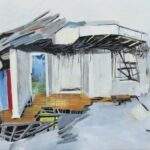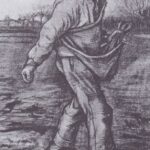
Van Gogh lived with his parents between 1883 and 1885 in Nuenen. During his time there, he met Antoon Hermans, a successful, retired goldsmith, with whom Van Gogh wanted “to remain on good terms if possible”. [1] From Van Gogh’s perspective, Hermans was “rich and has built a house that he’s filled with antiques again, and furnished with some very fine oak chests. He decorates the ceilings and walls himself, and really well sometimes.”[1]
Hermans was also an amateur painter, and Van Gogh took him on as a student. This may come as a surprise with the knowledge that Van Gogh began pursuing his artistic career only four years earlier. Van Gogh had previous teaching experience after taking up a position at a boy’s school in Ramsgate, England after he lost his job at Boupil & Cie, the Art Dealers in Paris in 1876. He really enjoyed his time teaching, so much so he questioned it, writing to Theo, “These are really happy days, the ones I’m spending here, day after day, and yet it’s a happiness and peacefulness that I don’t trust entirely, though one thing can lead to another.” [2] There was also material motivation behind Van Gogh teaching amateurs how to paint, as he told Theo, “I have a plan, though, to gradually get people to pay something — not in money, however, but by telling them ‘you must give me tubes of paint.’ [3] Van Gogh taught Hermans whilst he lived in Nuenen, and he also took on tanner Anton Kerssemakers and telegrapher Willem van de Wakker as students. Van Gogh taught them general painting techniques and how to paint still lifes.
Hermans was a particularly interesting student, because he wanted Van Gogh’s help to paint the interior walls of his house. Hermans had already painted flowers on twelve panels of his dining room, and he wanted Van Gogh to help him design images of saints for the remaining six panels. Van Gogh thought that scenes depicting the four seasons would be more suitable, and Shephard and his Flock above, is one of the images that Van Gogh created for Hermans to enlarge. This painting represented autumn. He has created a strong feeling of an oncoming stark winter with the angular, leafless trees. The contrast of the bright pasture and flock of white sheep against the dark, looming clouds and night setting in, vividly creates the feeling of a cold autumn evening.
As with a lot of Van Gogh’s work, Jean-Francois Millet’s influence can also be seen:

Van Gogh also used this project to improve his drawing of the human figure, as he engaged various models to complete the painting studies. He initially sketched an ox-cart in the snow (which was later replaced with wood-gatherers in the snow), a ploughman, a sower, a grain harvest, a potato harvest, and the above sower. He then created oil paintings from the sketches. Van Gogh made an agreement with Hermans that he would create six compositions for him to reproduce onto his walls, only if Hermans returned the paintings to him. It is unconfirmed if Hermans ever returned his paintings, or paid Van Gogh for the work.
Written by Lauren Ottaway
[1] Vincent van Gogh. Letter 229 to Theo van Gogh. Written Monday 4 August 1884
[2] Vincent van Gogh. Letter 229 to Theo van Gogh. Written Saturday 6 May 1876
[3] Vincent van Gogh. Letter 229 to Theo van Gogh. Written Monday 17 November 1874

